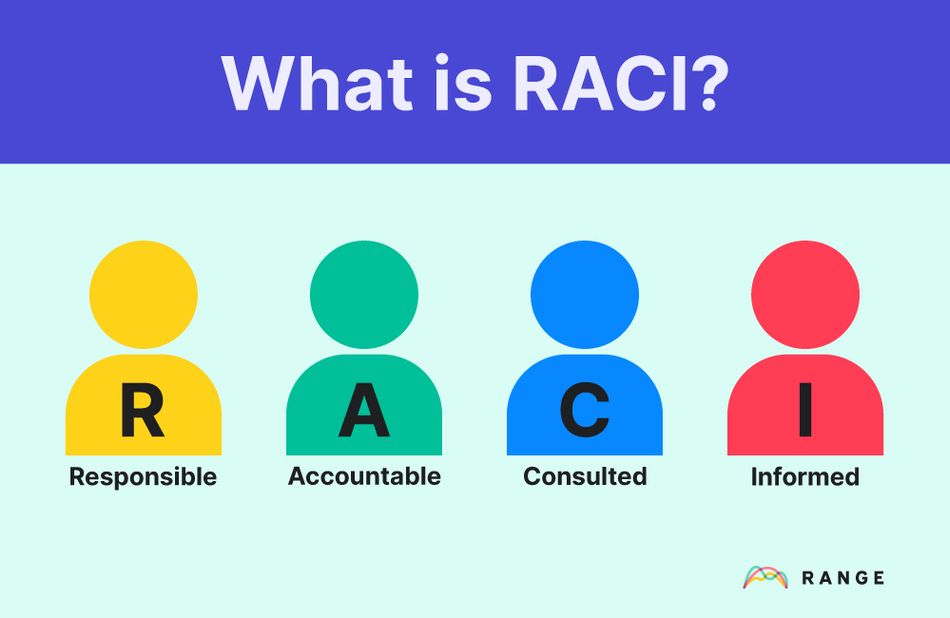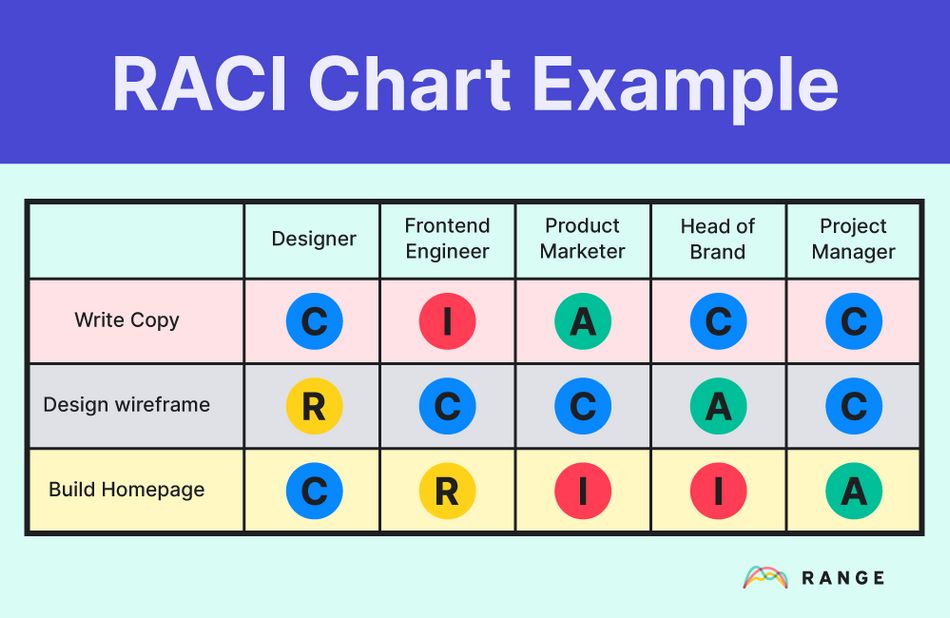
Ever worked on a project that churned on forever because no one had the final say?
Missed a deadline because it felt like everyone and no one was accountable at the same time?
Had no idea something major was about to launch that would directly impact your team?
Felt resentment towards a teammate for not staying in their lane?
Roles and responsibilities at work get murky a lot more often than we’d like to admit. Unclear roles slow teams down and create poor decision-making habits that ultimately cost organizations a lot of money each year. According to research from McKinsey, 61% of managers believe time spent making decisions at their organization is used ineffectively.
“The opportunity costs of this are staggering: about 530,000 days of managers’ time potentially squandered each year for a typical Fortune 500 company, equivalent to some $250 million in wages annually.” — 3 keys to faster, better decisions, McKinsey & Company
More effective decision making happens when folks across the organization—not just leadership—are empowered and accountable for moving projects forward. And the first step in achieving this is through clearly defined roles and responsibilities, made easy through something called a RACI chart.
What is a RACI chart?
A RACI chart is a type of responsibility assignment matrix which takes decisions, tasks, or deliverables and details each teammate’s responsibility-level in each. Teams use RACI charts to designate who’s tasked with for what on a given project and ensure the work moves forward smoothly, with everyone staying in their lanes.

What does RACI stand for?
RACI is an acronym that stands for: Responsible, Accountable, Consulted, Informed. Each letter in RACI represents a specific level of responsibility on a project. Here’s the breakdown.
Key:
- R = Responsible, the person creating the deliverable
- A = Accountable, the person with final decision-making power
- C = Consulted, people who provide input and feedback
- I = People who are looped into what’s happening
R: Responsible
In RACI, responsible individuals are those who are assigned to the work. They’re the doers and creators responsible for the project’s deliverables. There’s typically just one responsible individual for each stage of a project.
A: Accountable
Next, we’ve got the accountable individual—they’re the one who delegates work and has the final say when it comes to reviewing it and marking it complete. There should only ever be one accountable individual per project or task. Oftentimes this is a PM or product or function lead, but not always.
C: Consulted
The C in RACI stands for consulted—these are the individuals who provide input, feedback, and domain expertise. They might be stakeholders on the leadership level or teammates working in an overlapping product area who may be impacted by the work. There’s no required number when it comes to who should be consulted on a project. Generally speaking, the more input the better.
I: Informed
In RACI, informed individuals are those who need to be kept in the loop but don’t need to know every tiny detail as the project progresses. Same as with the consulted group, there’s no requirement in terms of how many or few informed individuals you have for a given project. It will depend on your team size and the nature of the work.
Example RACI Chart
Let’s say you’re creating a new homepage for your website. Here’s an example of what your RACI chart might look like.
RACI Chart Example

The pros of a RACI chart
RACI charts are used by teams across industries to bring clarity, transparency, and alignment. Here are a few of the main benefits.
1. Clarifies roles and responsibilities
Teammates can’t work to the best of their abilities if they don’t even know what they’re expected to own in the first place. RACI charts help clarify ownership so the team can work together more effectively. When everyone knows what they’re expected to contribute to a project, folks can work more autonomously and there’s less risk of micromanagement slipping in—since everyone’s clearly aligned on their role.
2. Improves accountability and empowers teammates
When people know what they’re responsible for it’s easier to build a culture of accountability.
On a team, accountability means the team follows through on its commitments, finishes projects on time, and meets its goals. On teams with strong accountability, ICs are empowered to take ownership of their work, communicate openly and often about commitments, and complete tasks they commit to in a timely manner.
3. Fosters a more collaborative work environment
It’s easier to collaborate with teammates when you’re not in a constant power struggle over who’s in charge of what. In this way, defining roles and responsibilities using the RACI frameworks fosters a more creative, collaborative environment where folks are excited to share work with one another and consult or give feedback on it.
It improves cross-team communication too, which can help improve alignment and avoid silos across the organization.
4. Makes the decision-making process more effective
RACI provides a clear framework for how to think about how decisions get made and who has the final say. When folks understand their role in a given project, it helps projects reach completion more smoothly, with less churn or endless rounds of feedback. When in doubt, the accountable individual makes the final call.
The cons of a RACI chart
RACI charts are helpful in many different situations, but some teams do experience challenges with them. Here are a few to be aware of.
1. They become too focused on granular tasks
Striking the balance between too granular of tasks and too broad can be tricky when building a RACI chart. A good rule of thumb is to break things apart by deliverable. In the new homepage example, we broke apart the bigger goal (a new homepage) into the individual deliverables that need to ship in order to make it happen. Had we gone even more granular with the deliverables (like breaking apart “Write copy” into “Write headline”, “Write body”, “Write captions”) we’d find ourselves creating many repeat lines in the RACI chart with the same project participants in the same roles — doing it that way doesn’t add value, it only adds extra noise.
Tip: Keep information flowing without overcomplicating your RACI chart
To avoid the problem of over-granularity, make sure you have other, regular communication channels where you’re keeping folks informed—both on the bigger picture deliverables, and on the day-to-day progress towards them. Range works well for this, because it allows folks to follow along with a project and sends out brief daily updates as things progress.
2. It’s hard to share updates and stay informed
The beauty of RACI is that you’ll have one designated decision-maker and a few key consultants, and then many folks who you'll want to inform along the way. This decision-making model helps you move more quickly. But in doing so, also makes it more difficult to keep your “informed” group in the loop as you go. (Especially if you don’t want to spend hours each week doing so.)
Tip: Use Range for fast, informative project updates
When you track projects in Range, it’s easy to share updates with RACI stakeholders in just a couple of minutes. Automatically pull in context too, so it’s easy to review the latest Figma, comment on the copy doc, or see what Asana tasks the team is working through next. And if you missed something, it’s easy to track down the latest simply by searching the project #tag.
3. They’re time-consuming to build
Especially when you’re first getting the hang of it, RACI charts can take some time to build. A good way to save time and get into the swing of things is to use a template when you’re starting out.
We put together one here that you can copy/paste and use as many times as you’d like.
When does it make sense to create a RACI chart?
RACI charts are particularly helpful for larger, cross-functional projects with a lot of moving pieces and dependencies.
Here are a few situations where RACI charts can also be really helpful:
- Approvals are messy and feedback and decision-making (or lack thereof) are holding up progress
- There’s conflict or confusion about who owns certain tasks or has the final call on certain decisions
- It feels like a few people (oftentimes PMs) are carrying the brunt of the workload
- Teammates tend to straddle multiple projects at once, so you want to make sure everyone knows what they’re responsible for to prevent blockers
- Your team is growing and/or you have a lot of new folks on the team who you want to quickly onboard
For small projects, super-individualized projects, or projects where you’ve already got a great workflow and open communication in place—you probably don’t need a RACI matrix. It’s a great tool to have in your backpocket though and can easily bring clarity if things go astray.
Best practices for creating a team RACI chart
If you’re going to take the time to build a RACI chart, it’s important to do it right. Here are a few guiding principles that can help ensure you’re putting the practice to good use.
1. Balance responsibilities among all members involved
A key point of the RACI chart is that responsibility should be equally divided among team members. If you find you’re constantly assigning the same person as A or R all the time, it’s not a very equal balance. Ask yourself, who else can step up and take ownership of the project at this stage? Give everyone on the team a chance to lead where appropriate.
Tip: One R at a time
If you find yourself wanting to assign more than one responsible individual, it’s probably a sign that that part of the project can be broken up into two separate deliverables in your RACI chart.
2. Fill it all in, every time
No. Blank. Spaces. As you go through each deliverable on your chart, be sure to assign a role for each team member. Folks who don’t have an active role to play for that particular step should still be informed (I) to ensure open communication throughout the project.
Make sure all team members are represented in your RACI chart and get a chance to agree to the roles you’ve laid out before making anything official.
Tip: Make it easy to keep Cs and Is in the know
If you have a lot of Consulted and Informed teammates on your RACI chart, make sure you have a lightweight way to share updates with them as you go. It could be as simple a quick Slack update or a brief daily Check-in with Range.
Keep your team organized and in the know with Range
Empowering your team with the RACI framework is a win for everybody involved. For individuals, it gives power and ownership to run with projects, build strong relationships with stakeholders, and find purpose and pride in their work.
For teams, RACI helps improve the flow of information and trust between members. And for the business, RACI means faster alignment, less churn, and a continuous push towards results.
Not every project needs RACI, but many can benefit from the clarity and transparency the chart provides. And once you start using the RACI framework, Range is the easiest way to track project updates and keep everyone—R, A, C, or I—accountable and in-the-know.
- Assign clear project owners for goals and deliverables
- Share lightweight updates to keep every stakeholder in the know
- Include context and link to your other tools so it’s easy for Cs to provide feedback, Is to follow along with your project one-pager, and more
- Organize tasks and sub-tasks, and make them easily searchable with a #tag








